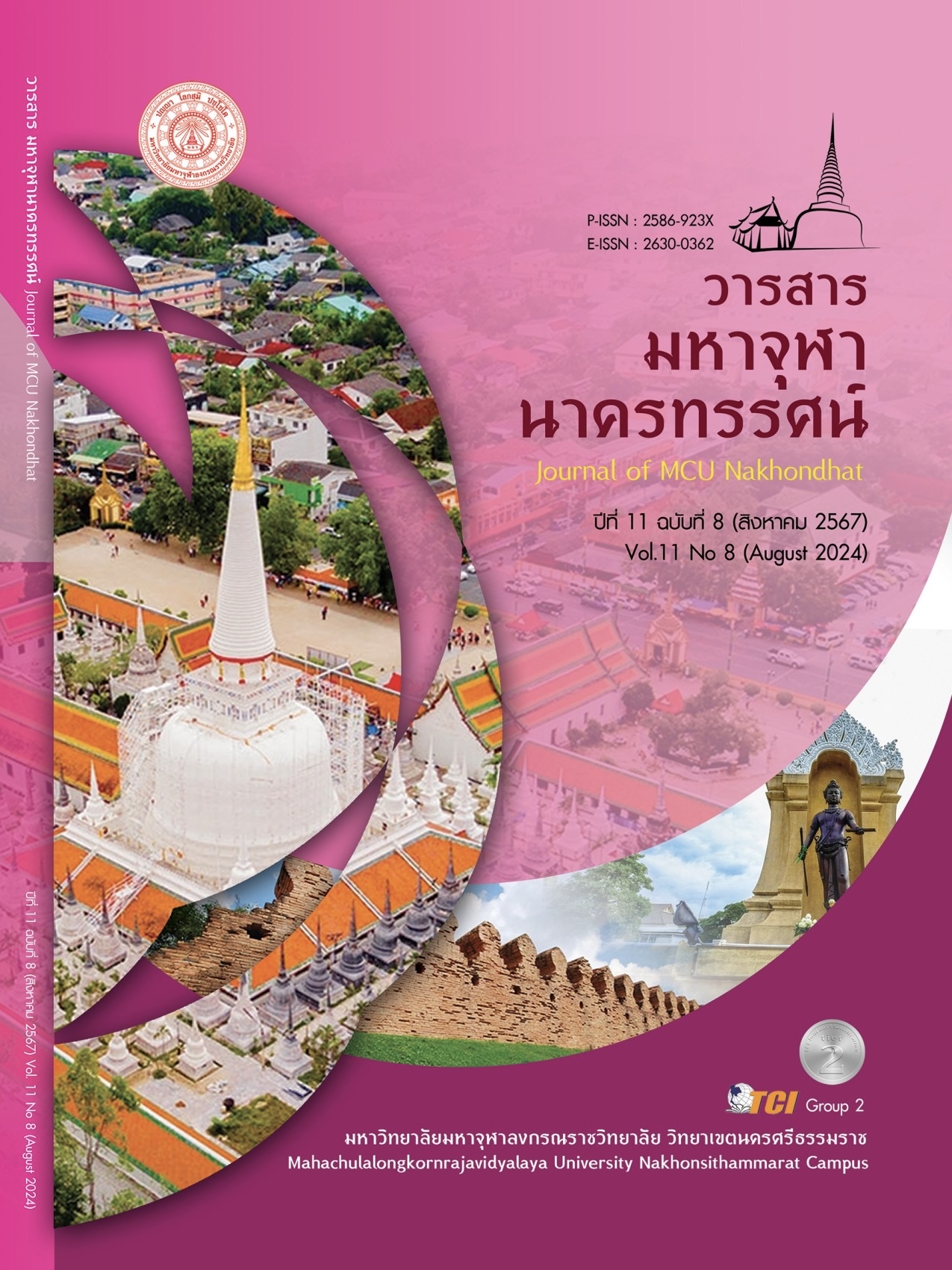EFFECTS OF USING A CREATIVITY-BASED LEARNING APPROACH ON CRITICAL READING ABILITIES REGARDING THAI LITERATURE AND ATTITUDES TOWARDS LEARNING ABOUT THAI LITERATURE OF BECHELOR OF EDUCATION STUDENTS IN THAI MAJOR
Main Article Content
Abstract
The research aimed to compare scores resulting from the critical reading abilities regarding Thai literature and attitudes towards learning about Thai literature prior to and after learning through a Creativity-Based Learning (CBL) approach. The research design adopted quasi-experimental research. The target population comprised 38 students who studied in a Bachelor of Education (B.Ed.) programme in Thai major in the first academic year 2024 at Rattanophat University (pseudonym) in Bangkok, Thailand. The B.Ed. students were selected by using a purposive sampling approach. The instruments for data collection consisted of a critical reading abilities test and an attitude questionnaire. The data collection instruments were given to those students to provide answers prior to and after the experiment, namely learning through a CBL approach. The instruments for the experiment comprised lesson plans were designed following a CBL approach. Each lesson plan designed for a teaching session which comprised 50 minutes. The experiment was conducted on every Thursday which was apart from university’s time schedule. The experiment was undertaken for 12 weeks, 1 session per week. The scores resulting from the test and the questionnaire were examined to check their median score and standard deviation. Additionally, the scores were statistically analyzed through Wilcoxon signed rank test to compare the difference of median scores. The findings showed that 1) Students who were taught following CBL approach had critical reading abilities regarding Thai literature higher than prior to the experiment at 0.05 level of statistical significance and 2) Students who were taught following CBL approach had attitudes towards learning about Thai literature higher than before the experiment at 0.05 level of statistical significance. Additionally, recommendations were made for further studies suggesting that teachers can apply a CBL approach to teaching literary criticism. This approach can enhance student learning practices related to literature interpretation, analysis, and criticism.
Article Details

This work is licensed under a Creative Commons Attribution-NonCommercial-NoDerivatives 4.0 International License.
References
ปรีชา ช้างขวัญยืน. (2560). ปรีชาวิทรรศน์: มุมมองภาษาไทย. กรุงเทพมหานคร: สำนักพิมพ์แห่งจุฬาลงกรณ์มหาวิทยาลัย.
เผ่าไทย เสียงแจ่ม และสัณหณัฐ ทองไทย. (2564). ผลของการจัดการเรียนรู้แบบสร้างสรรค์เป็นฐานที่มีต่อผลสัมฤทธิ์ทางการเรียนวิชาสังคมศึกษาและความคิดสร้างสรรค์ของนักเรียนชั้นมัธยมศึกษาปีที่ 3. วารสารครุศาสตร์ มหาวิทยาลัยราชภัฎนครสวรรค์, 4(1), 62-70.
ลัดดา ศิลาน้อย. (2558). การวิจัยพัฒนาทักษะการเรียนรู้ ในศตวรรษที่ 21 และผลสัมฤทธิ์ทางการเรียนโดยใช้รูปแบบการสอนแบบสร้างสรรค์เป็นฐาน (CBL) ของนักเรียนชั้นมัธยมศึกษาปีที่ 1 รายวิชา ส 21103 สังคมศึกษา 2. วารสารศึกษาศาสตร์มหาวิทยาลัยขอนแก่น, 38(4), 141-148.
วะรุฬพันธ์ โหม่งมาตย์. (2566). การพัฒนาทักษะการอ่านของนักเรียนชั้นมัธยมศึกษาปีที่ 5 ด้วยกระบวนการจัดการเรียนรู้แบบออนไลน์ตามรูปแบบแมโคร (MACRO Model). วารสารรามคำแหง ฉบับคณะศึกษาศาสตร์ (มนุษยศาสตร์และสังคมศาสตร์), 4(2), 23-33.
วิริยะ ฤาชัยพานิชย์. (2558). การสอนแบบสร้างสรรค์เป็นฐาน Creativity Based Learning (CBL). วารสารนวัตกรรมการเรียนรู้, 1(2), 23-37.
วิริยะ ฤาชัยพานิชย์. (2557). เปลี่ยนการศึกษาไทยสู่ศตวรรษที่ 21. กรุงเทพมหานคร: สำนักงานอุทยานการเรียนรู้.
เวทิสา ตุ้ยเขียว และคณะ. (2563). แนวทางการจัดการเรียนรู้แบบสร้างสรรค์เป็นฐานที่ส่งเสริมสมรรถนะการแก้ปัญหาแบบร่วมมืออย่างสร้างสรรค์ของนักเรียนในระดับชั้นมัธยมศึกษาปีที่ 4 เรื่อง ปฏิกิริยาเคมี. วารสารศึกษาศาสตร์ มหาวิทยาลัยนเรศวร, 22(1), 237-248.
อรวรรณ อุดมสุข. (2564). ผลการจัดการเรียนรู้แบบสร้างสรรค์เป็นฐาน (CBL) ร่วมกับสื่ออินโฟกราฟิกที่มีต่อผลสัมฤทธิ์ทางการเรียนวรรณคดีไทย เรื่อง กาพย์พระไชยสุริยา ของนักเรียนชั้นมัธยมศึกษาปีที่ 1. ใน สารนิพนธ์ศึกษาศาสตรมหาบัณฑิต สาขาวิชาภาษาไทย. มหาวิทยาลัยนเรศวร.
อิงอร สุพันธุ์วณิช. (2565). วิเคราะห์เจาะลึกวรรณคดีไทยในแบบเรียนมัธยมศึกษา. อุบลราชธานี: โรงพิมพ์มหาวิทยาลัยอุบลราชธานี.
Anugerahwati, M. et al. (2021). Maximizing students’ critical reading through virtual literature circle strategy: A conceptual framework. International Seminar on Language, Education, and Culture. KnE Social Sciences, 5(3), 221-227.
Atthachakara, S. (2021). Developing Practical Skills Through Blended Learning Model Using Creativity-Based Learning Activites that Enhances Creative Thinking for Education Students Majoring in Social Studies at Mahasarakham University. Journal of Education and Learning, 10(6), 126-131.
Cohen, L. et al. (2018). Research Methods in Education. (8th ed.). London: Routledge.
Creswell, J. W. & Guetterman, T. C. (2019). Educational Research: Planning, Conducting, and Evaluating Quantitative and Qualitative Research. (6th ed.). New York: Pearson Education.
Eggen, P. D. & Kauchak, D. P. (2016). Educational Psychology: Windows on Classrooms. (10th ed). Essex: Pearson Education.
Eman, E. S. (2017). Augmenting Tertiary Students’ Soft Skills Via Multiple Intelligence Instructional Approach: Literature Courses in Focus. International Journal of Applied Linguistics & English Literature, 6(2), 230-238.
Jocius, R. & Shealy, S. (2018). Critical book clubs: Reimagining literature reading and response. The Reading Teacher, 71(6), 691-702.
Kankaew, R. (2020). Using a Creativity-based Learning Approach to Enhancing Product Creative Skill of Undergraduate Students in Communication Arts under COVID 19: The Case Study of Sripatum University, Thailand. In Osman Titrek (Ed.), International Conference on Lifelong Education and Leadership. Sakarya University.
Kaya, A. & Bilen, S. (2016). Assessment of Creativity-Based Learning Environment for Major Instrument Courses: A Case Study of Buca Faculty of Education, Department of Music Education. Online Submission, 13(2), 3102-3111.
Maltepe, S. (2016). An analysis of the critical reading levels of pre-service Turkish and literature teachers. Eurasian Journal of Educational Research, 63(2016), 169-184.
Meeplat, N. (2020). A Model of Creativity Based Learning for Computer teaching to enhance Creative skills of undergraduate students. In Proceedings of the 2020 the 3rd International Conference on Computers in Management and Business. Tokyo: Association for Computing Machinery.
Mozafari, A. & Barjesteh, H. (2016). Enhancing literary competence through critical oriented reading strategies. International Journal of Applied Linguistics and English Literature, 5(7), 168-177.
Nakornthap, A. (2018). Rethinking Thai Secondary Education. In Gerald W. Fry (Ed.), Education in Thailand: An Old Elephant in Search of a New Mahout. (pp.125-161). Singapore: Springer.
Pettongma, P. W. C. (2024). Creativity-Based Learning Model in Thailand Context. Intersecta Minds Journal, 5(2), 62-74.
Rokhayati, T. & Alvionita, E. (2022). The Use of Online Literature Circles to Enhance the Students’ Critical Reading Skills. Journal of Languages and Language Teaching, 10(1), 94-101.
Salkind, N. J. (2017). Statistics for People Who (Think about) Hate Statistics. (6th ed). London: SAGE Publications.
Woolfolk, A. (2018). Educational Psychology: Global Edition. (14th ed). Essex: Pearson Education.
Yonwilad, W. & Sinlapaninman, U. (2022). Blended Learning and Creativity-Based Learning for Promoting Mathematics Achievement and Information Technology Performance. Journal of Educational Issues, 8(1), 535-545.


